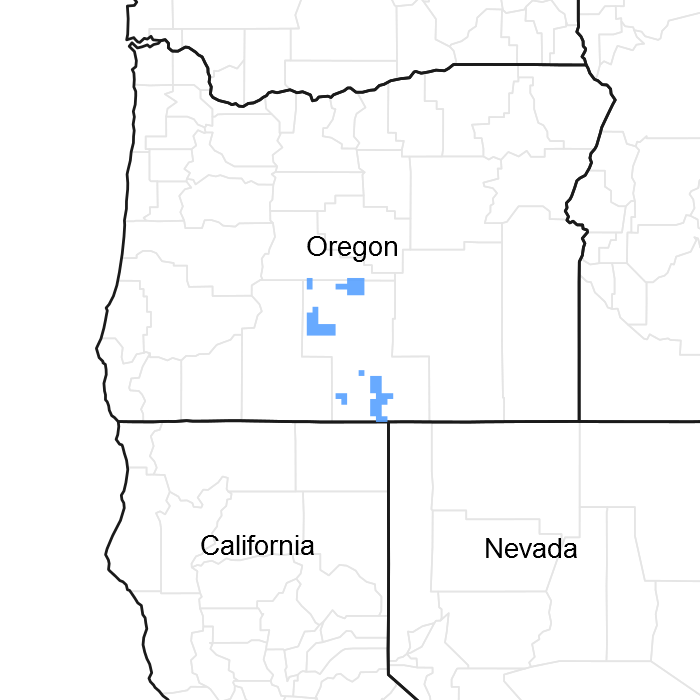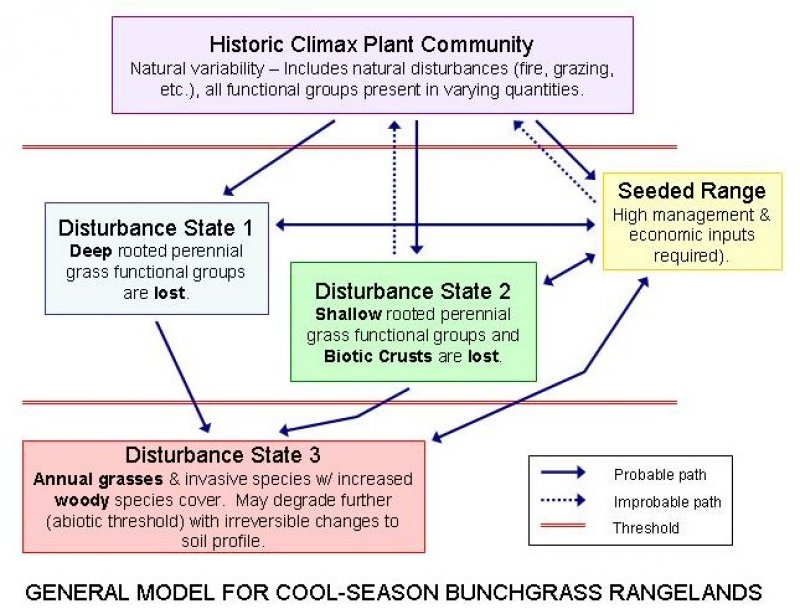
Natural Resources
Conservation Service
Ecological site R021XY204OR
SHALLOW STONY 10-20 PZ
Accessed: 12/20/2025
General information
Provisional. A provisional ecological site description has undergone quality control and quality assurance review. It contains a working state and transition model and enough information to identify the ecological site.

Figure 1. Mapped extent
Areas shown in blue indicate the maximum mapped extent of this ecological site. Other ecological sites likely occur within the highlighted areas. It is also possible for this ecological site to occur outside of highlighted areas if detailed soil survey has not been completed or recently updated.
Associated sites
| R021XY206OR |
DEEP LOAMY 10-14 PZ Deep Loamy 10-14" PZ |
|---|---|
| R021XY208OR |
SANDY 10-14 PZ Sandy 10-14" PZ |
Similar sites
| R021XY214OR |
CLAYPAN 14-18 PZ Claypan 14-18" PZ (Soils clayey) |
|---|
Table 1. Dominant plant species
| Tree |
Not specified |
|---|---|
| Shrub |
Not specified |
| Herbaceous |
Not specified |
Physiographic features
This site occurs on tablelands. Slopes range from 1 to 35% but are typically from 1 to 8%. Elevations range from 4000 to 5500 feet.
Table 2. Representative physiographic features
| Landforms |
(1)
Plateau
|
|---|---|
| Elevation | 4,000 – 5,500 ft |
| Slope | 1 – 35% |
| Aspect | Aspect is not a significant factor |
Climatic features
The annual precipitation is over 10 inches, most of which occurs in the form of snow during the months of October through May. the soil temperature regime is frigid with the mean annual air temperature of about 45 degrees F. Temperature extremes range from 100 to -30 degrees F. The frost free period ranges from 50 to 70 days. The optimum period for plant growth is from April through May.
Table 3. Representative climatic features
| Frost-free period (average) | 70 days |
|---|---|
| Freeze-free period (average) | 0 days |
| Precipitation total (average) | 20 in |
Influencing water features
Soil features
The soils of this site are shallow to bedrock and have a clayey subsoil. The soil surface is typically covered with 30 to 65% rock fragments, primarily stones. Permeability is very slow. The available water holding capacity is 1 to 4 inches. Runoff is rapid. Erosion hazard by water is moderate.
Table 4. Representative soil features
| Family particle size |
(1) Clayey |
|---|---|
| Permeability class | Very slow |
| Surface fragment cover >3" | 30 – 65% |
| Available water capacity (0-40in) |
1 – 4 in |
Ecological dynamics
Variability in the thickness of the soil surface and the amount of coarse fragments affect production and composition on this site. An increase in surface thickness will promote higher production and increase the amount of bluebunch wheatgrass and low sagebrush. Idaho fescue will occur at the upper end of the precipitation range.
If the condition of the site deteriorates as a result of overgrazing, Sandberg bluegrass and other perennial bunchgrasses will decline in the stand. the site is susceptible to invasion by cheatgrass, willow-weed and other annuals. Western juniper may invade the site.
State and transition model

More interactive model formats are also available.
View Interactive Models
More interactive model formats are also available.
View Interactive Models
Click on state and transition labels to scroll to the respective text
Ecosystem states
State 1 submodel, plant communities
State 1
HCPC, POSE/ARAR8
Community 1.1
HCPC, POSE/ARAR8
The potential native plant community is dominated by low sagebrush and Sandberg bluegrass. A variety of perennial forbs occur throughout the stand. Vegetative composition of the community is approximately 70% grasses, 10% forbs and 20% shrubs.
Figure 2. Annual production by plant type (representative values) or group (midpoint values)
Table 5. Annual production by plant type
| Plant type | Low (lb/acre) |
Representative value (lb/acre) |
High (lb/acre) |
|---|---|---|---|
| Grass/Grasslike | 216 | 258 | 300 |
| Shrub/Vine | 52 | 80 | 108 |
| Forb | 32 | 48 | 64 |
| Tree | 20 | 30 | 40 |
| Total | 320 | 416 | 512 |
Figure 3. Plant community growth curve (percent production by month). OR5511, D21 Low Elev., NA, Good Condition. RPC Growth Curve.
| Jan | Feb | Mar | Apr | May | Jun | Jul | Aug | Sep | Oct | Nov | Dec |
|---|---|---|---|---|---|---|---|---|---|---|---|
| J | F | M | A | M | J | J | A | S | O | N | D |
| 0 | 0 | 15 | 30 | 50 | 5 | 0 | 0 | 0 | 0 | 0 | 0 |
Additional community tables
Table 6. Community 1.1 plant community composition
| Group | Common name | Symbol | Scientific name | Annual production (lb/acre) | Foliar cover (%) | |
|---|---|---|---|---|---|---|
|
Grass/Grasslike
|
||||||
| 2 | Sub-dominant deep rooted perennial grasses | 8–20 | ||||
| bluebunch wheatgrass | PSSP6 | Pseudoroegneria spicata | 8–20 | – | ||
| 3 | Dominant shallow rooted perennial grasses | 200–260 | ||||
| Sandberg bluegrass | POSE | Poa secunda | 200–260 | – | ||
| 5 | Other perennial grasses | 8–20 | ||||
| Thurber's needlegrass | ACTH7 | Achnatherum thurberianum | 0–5 | – | ||
| squirreltail | ELEL5 | Elymus elymoides | 0–5 | – | ||
| Idaho fescue | FEID | Festuca idahoensis | 0–5 | – | ||
| prairie Junegrass | KOMA | Koeleria macrantha | 0–5 | – | ||
|
Forb
|
||||||
| 7 | Dominant perennial forbs | 28–44 | ||||
| Hooker's balsamroot | BAHO | Balsamorhiza hookeri | 8–12 | – | ||
| buckwheat | ERIOG | Eriogonum | 8–12 | – | ||
| desertparsley | LOMAT | Lomatium | 8–12 | – | ||
| largehead clover | TRMA3 | Trifolium macrocephalum | 4–8 | – | ||
| 9 | Other perennial forbs | 4–20 | ||||
| rockcress | ARABI2 | Arabis | 0–5 | – | ||
| milkvetch | ASTRA | Astragalus | 0–5 | – | ||
| Indian paintbrush | CASTI2 | Castilleja | 0–5 | – | ||
| willowherb | EPILO | Epilobium | 0–5 | – | ||
| fleabane | ERIGE2 | Erigeron | 0–5 | – | ||
| lupine | LUPIN | Lupinus | 0–5 | – | ||
| woolly plantain | PLPA2 | Plantago patagonica | 0–5 | – | ||
|
Shrub/Vine
|
||||||
| 11 | Dominant evergreen shrubs | 40–80 | ||||
| little sagebrush | ARAR8 | Artemisia arbuscula | 40–80 | – | ||
| 12 | Sub-dominant evergreen shrubs | 8–20 | ||||
| slender buckwheat | ERMI4 | Eriogonum microthecum | 8–20 | – | ||
| 14 | Sub-dominant deciduous (or 1/2 shrubs) shrubs | 4–8 | ||||
| antelope bitterbrush | PUTR2 | Purshia tridentata | 4–8 | – | ||
|
Tree
|
||||||
| 16 | Dominant evergreen trees | 20–40 | ||||
| western juniper | JUOC | Juniperus occidentalis | 20–40 | – | ||
Interpretations
Animal community
This site is often used by sage grouse for strutting grounds.
Hydrological functions
The soils are in hydrologic group D.
Recreational uses
This site offers bird watching opportunities when sage grouse are present.
Other products
This site has limited suitability for livestock grazing. Grazing should be postponed until soils are dry.
Other information
The shallow soils and stony surface limit potential for seeding, pipelines, etc., and require special design considerations for fencing.
Supporting information
Type locality
| Location 1: Klamath County, OR | |
|---|---|
| Township/Range/Section | T38S R12E S25 26 |
| General legal description | Just SW of Keno Meadow at edge of Capon Flat: T38S, R12E, Sec 25 or 26 |
Contributors
Carlson, Barrett
E Ersch
E Ersch (OSU)
K.Kennedy
Rangeland health reference sheet
Interpreting Indicators of Rangeland Health is a qualitative assessment protocol used to determine ecosystem condition based on benchmark characteristics described in the Reference Sheet. A suite of 17 (or more) indicators are typically considered in an assessment. The ecological site(s) representative of an assessment location must be known prior to applying the protocol and must be verified based on soils and climate. Current plant community cannot be used to identify the ecological site.
| Author(s)/participant(s) | Jeff Repp |
|---|---|
| Contact for lead author | Oregon NRCS State Rangeland Management Specialist |
| Date | 08/21/2012 |
| Approved by | Bob Gillaspy |
| Approval date | |
| Composition (Indicators 10 and 12) based on | Annual Production |
Indicators
-
Number and extent of rills:
None to some, moderate to significant sheet & rill erosion hazard -
Presence of water flow patterns:
Few to many in rock/vegetation interspaces -
Number and height of erosional pedestals or terracettes:
Few to many (particularly Sandberg bluegrass) -
Bare ground from Ecological Site Description or other studies (rock, litter, lichen, moss, plant canopy are not bare ground):
1-10% -
Number of gullies and erosion associated with gullies:
None -
Extent of wind scoured, blowouts and/or depositional areas:
None, slight wind erosion hazard -
Amount of litter movement (describe size and distance expected to travel):
Fine - limited movement -
Soil surface (top few mm) resistance to erosion (stability values are averages - most sites will show a range of values):
Moderately resistant to erosion: aggregate stability = 4-6 -
Soil surface structure and SOM content (include type of structure and A-horizon color and thickness):
Shallow, well drained very cobbly or very stony loams (covered with 30-65% rock fragments): Low OM (1%) -
Effect of community phase composition (relative proportion of different functional groups) and spatial distribution on infiltration and runoff:
Nearly level aspect, moderate ground cover (30-60%), high amount of surface rock fragments and moderate slopes (0-30%) effectively limits rainfall impact and overland flow; infiltration rates are usually very low -
Presence and thickness of compaction layer (usually none; describe soil profile features which may be mistaken for compaction on this site):
None -
Functional/Structural Groups (list in order of descending dominance by above-ground annual-production or live foliar cover using symbols: >>, >, = to indicate much greater than, greater than, and equal to):
Dominant:
Sandberg bluegrass > Low sagebrush > other grasses = forbs > Shrubby buckwheat > Antelope bitterbrushSub-dominant:
Other:
Additional:
-
Amount of plant mortality and decadence (include which functional groups are expected to show mortality or decadence):
Normal decadence and mortality expected -
Average percent litter cover (%) and depth ( in):
-
Expected annual annual-production (this is TOTAL above-ground annual-production, not just forage annual-production):
Favorable: 600, Normal: 400, Unfavorable: 250 lbs/acre/year at high RSI (HCPC) -
Potential invasive (including noxious) species (native and non-native). List species which BOTH characterize degraded states and have the potential to become a dominant or co-dominant species on the ecological site if their future establishment and growth is not actively controlled by management interventions. Species that become dominant for only one to several years (e.g., short-term response to drought or wildfire) are not invasive plants. Note that unlike other indicators, we are describing what is NOT expected in the reference state for the ecological site:
Perennial brush species will increase with deterioration of plant community. Western Juniper readily invades the site. Cheatgrass and Medusahead invade sites that have lost deep rooted perennial grass functional groups. -
Perennial plant reproductive capability:
All species should be capable of reproducing annually
Print Options
Sections
Font
Other
The Ecosystem Dynamics Interpretive Tool is an information system framework developed by the USDA-ARS Jornada Experimental Range, USDA Natural Resources Conservation Service, and New Mexico State University.
Click on box and path labels to scroll to the respective text.